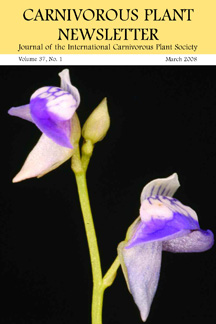International Carnivorous Plant Society
Carnivorous Plant Newsletter Archive
Floral dimorphism in Utricularia janarthanamii
Sardesai, M. M. and S. R. Yadav
Carniv. Pl. Newslett. 37(1):12-14
Published 22 March 2008
https://doi.org/10.55360/cpn371.ms713
Summary
The majority of flowering plants produce chasmogamous flowers, which require external agencies like wind, water, or animals for pollination to set fruit. Cleistogamous flowers are reduced flowers that never open and thus show obligate autogamy. Cleistogamous flowers are not uncommon, but chiefly occur in allogamous species, frequently after the conventional allogamous flowers have failed to set seeds. The development of cleistogamous flowers ensures seed is set in the absence of outcrossed seed, but may also produce less-fit offspring. In some plants only cleistogamous flowers are produced, which do not require external agencies for pollination to set fruit. Anderson (1980) reported a bizarre and intriguing way in which these flowers achieve self-fertilization.
Keywords: observations: Utricularia janarthanamii, Field studies: flowering
Article Citation
Sardesai, M. M. and S. R. Yadav. 2008. Floral dimorphism in Utricularia janarthanamii. Carniv. Pl. Newslett. 37(1):12-14. https://doi.org/10.55360/cpn371.ms713
Page views: 1000
©2025 International Carnivorous Plant Society
www.carnivorousplants.org
This page is maintained by John Brittnacher.
Please contact us at our membership website, icps.clubexpress.com.
Privacy: The Carnivorous Plant Newsletter Archive website does not track users.

